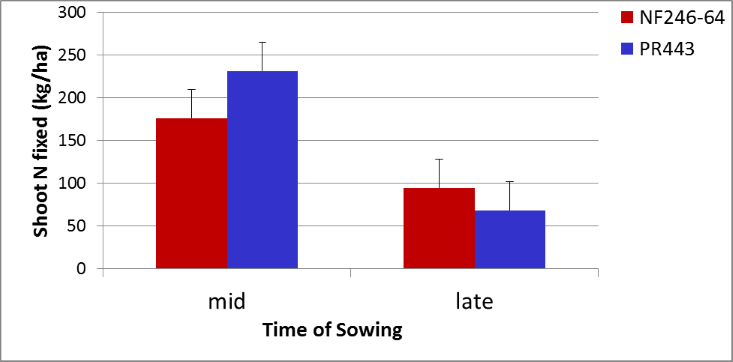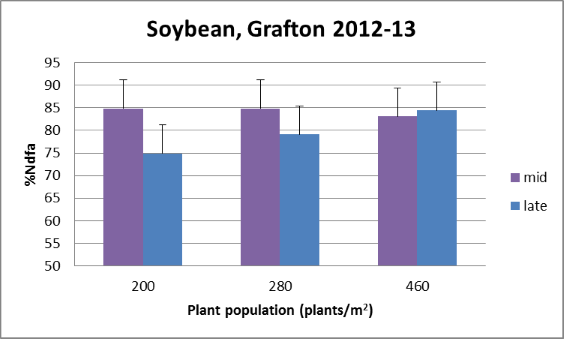Fixing more nitrogen in pulse crops
Author: Nikki Seymour, Kerry McKenzie and Stephen Krosch (Department of Agriculture and Fisheries), RCN Rachaputi (Queensland Alliance of Agriculture and Food Innovation) | Date: 31 Jul 2015
Take home message
- The amount of N fixed by a pulse crop is largely influenced by how well that crop grows. More crop biomass =more N fixed by that crop provided it is well nodulated.
- The amount of N fixed by a legume does not equal the amount available for the next crop. N is removed in the harvested grain and that N remaining in the crop residue then needs to be mineralised by microbial activity before it is available to the next crop.
- Row spacing in chickpeas of 0.25 lead to greater biomass, yield and increased N fixation than at 1.0m
- Sowing at the optimum time for maximum crop biomass leads to greater amounts of N fixed.
Nitrogen fixation
In Australia, legume-rhizobia associations are estimated to fix approximately 2.7 million tonnes of nitrogen (N) each year, worth about $4 billion. On average, this equates to about 110 kg of N per hectare per year, however the range of values can be from zero to 400 kg N/ha.
The actual amount fixed depends on the species of legume grown, the site and the seasonal conditions as well as agronomic management of the crop or pasture. The legume crop uses this N for its own growth and may fix significantly more than needed, leaving a positive N balance in the soil for proceeding crops. Estimates of the amounts of N fixed annually by some crop legumes in Australia are given below in Table 1. These are averages based on many studies over many seasons so do not represent every paddock. They do indicate the relative differences between legume species in their capacity to fix N.
The amount of N fixed by a legume increases as legume biomass increases but is reduced by high levels of soil nitrate. In general, legume reliance on N fixation is high when soil nitrate levels are below 50 kg N/ha in the top metre of soil. Above 200 kg N/ha, nitrogen fixation is generally close to zero. The fixed N is used for the growth of the legume itself (saving fertiliser application of the legume crop) as well as potentially leaving residual N for the following cereal or oilseed crop and providing a break from cereal stubble and soil-borne diseases.
Maximising N fixation in grain legumes is dependent on firstly inoculating the legume seed with the appropriate rhizobia strain (Group), then optimising basic agronomy so as to maximise legume productivity. Nitrogen fixation is directly related to biomass production for a particular species if that crop is well nodulated. Other factors though such as soil nitrate levels will influence the amount of N fixed by that crop.
Table 1. Estimates of average amounts of N fixed annually by different crop legumes in Australia.
|
Legume |
%N fixed |
Shoot dry matter (t/ha) |
Total crop N (kg/ha) |
Total N fixed (kg/ha) |
|
Soybean |
48 |
10.8 |
373 |
180 |
|---|---|---|---|---|
|
Faba bean |
65 |
4.3 |
172 |
110 |
|
Pea |
66 |
4.8 |
162 |
105 |
|
Peanut |
36 |
6.8 |
268 |
95 |
|
Chickpea |
41 |
5.0 |
170 |
70 |
|
Mungbean |
31 |
3.5 |
109 |
34 |
|
Navy bean |
20 |
4.2 |
148 |
30 |
Agronomy influences N fixation
The impacts of varying agronomic practices on N fixation are being assessed on trials grown in different environments under the GRDC Pulse Agronomy Initiative in the northern region. Two aspects, row spacing and time of sowing, will be discussed below.
Row spacing
Two trials conducted recently on the Downs (near Goondiwindi and Dalby) were assessed for the amount of N fixation at different row spacings (all at the same plant population of 30 plants/m2.) Yields were considerably lower at the Goondiwindi site (ranged from 1.5 to 2.1 t/ha) compared to the Dalby site (from 3.2 to 4.7 t/ha) due largely to better seasonal conditions at Dalby, and there was a significant site x genotype x row spacing interaction. Generally, yield and biomass production were reduced as row spacing increased but the amount differed for each genotype. There were no differences in N fixation amongst varieties but row spacing significantly decreased the percent of N fixation (also called %N derived from the atmosphere or %Ndfa) and the total amount of N fixed, particularly at the Dalby site (Table 2).
Up to 59 kg N/ha remained at the Dalby site when chickpeas were grown on 0.25m rows but only 23 kg N/ha from the 1.0 m row spacing. At Goondiwindi, the net N balance ranged from 6 down to -6 kg N/ha as row spacing increased from 0.25m to 1.0m. As a crops’ demand for N increased so did the N fixation by that crop as seen at our Dalby trial grown under better seasonal conditions.
Table 2. Reduction in biomass, N fixation (%N derived from the atmosphere or %Ndfa) and total amount of N fixed in chickpea (meaned across 3 genotypes) as row spacing in the field increases.
|
Shoot dry weight (t/ha) |
%Ndfa |
Total crop N fixed (kg/ha) |
N balance (kg/ha) |
|||||
|
Row spacing (m) |
Dalby |
Goondi |
Dalby |
Goondi |
Dalby |
Goondi |
Dalby |
Goondi |
|---|---|---|---|---|---|---|---|---|
|
0.25 |
9.89 |
4.75 |
61.0 |
39.2 |
187.3 |
62.8 |
59 |
6 |
|
0.5 |
9.25 |
4.23 |
55.8 |
33.9 |
161.9 |
48.0 |
45 |
-5 |
|
1.0 |
7.96 |
3.59 |
47.6 |
35.4 |
122.5 |
42.0 |
23 |
-6 |
|
LSD (P=0.05) |
1.12 |
0.67 |
7.0 |
n.s. |
31.5 |
16.3 |
n.s. |
n.s. |
Time of sowing
Sowing on time to take full advantage of soil water and growing conditions that maximise crop production can make a significant impact on amount of N fixed. The graph below gives an indication of the impact that time of sowing of soybeans can have on N fixation comparing soybeans planted in the middle of the appropriate planting window with late in that window. Figure 1 show that for two different soybean varieties (NF246-64 and PR443) as much as 150kg/ha less N is fixed due to the shortened growing season. However, increasing the plant population becomes very important for improving the proportion of N that is fixed if time of sowing is delayed.

Figure 1. Nitrogen fixation is reduced when soybeans are sown late in the planting window
(LSD (5%)= 33.2 ) .

Figure 2. Higher plant populations compensate partially for a later planted soybean crop in terms of N fixation (LSD (5%) = 8.7)
Acknowledgements
The research undertaken as part of this project is made possible by the significant contributions of growers through both trial cooperation and the support of the GRDC, the author would like to thank them for their continued support. Many thanks also to all members of the GRDC Pulse Agronomy Initiative in Qld and NSW.
Contact details
Nikki Seymour
Department of Agriculture and Fisheries
Ph: 07 46398837
Fx: 07 46398800
Email: nikki.seymour@daf.qld.gov.au
Was this page helpful?
YOUR FEEDBACK
